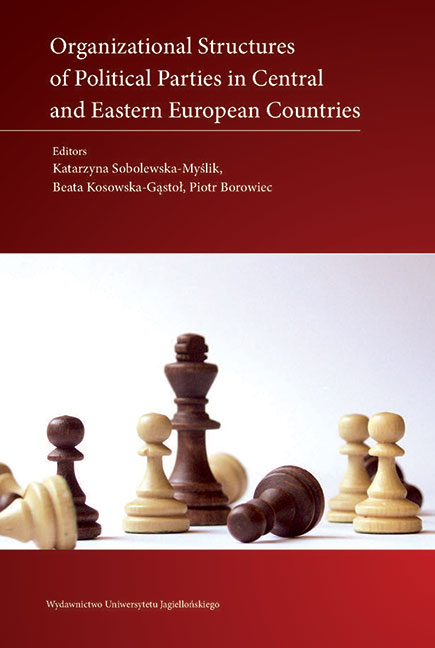Book contents
- Frontmatter
- Contents
- Preface
- Developing Party Structures in Central and Eastern Europe
- Albania: Organizations of Political Parties in Albania
- Belarus: Belarusian Political Parties: Organizational Structures and Practices
- Bosnia and Herzegovina: Organizational Structures of Political Parties in CEE Countries: A Case Study on Bosnia and Herzegovina
- Bulgaria: Organizational Structure and Trends in Bulgarian Party Politics
- Croatia: Organizational Structures of Political Parties in Croatia
- Czech Republic: Between Organizational Extremes: Czech Parties after a Political Earthquake
- Estonia: Organizational Structures of Political Parties in Estonia
- Hungary: Cut from the Same Cloth? A Comparative Analysis of Party Organizations in Hungary
- Kosovo: Structure of the Main Political Parties in Kosovo
- Latvia: Leader-Centered and Power-Hungry: Party Organizations in Latvia
- Lithuania: Organization of Political Parties: The Case of Lithuania
- Moldova: Organizational Structures of Political Parties in The Republic of Moldova
- Montenegro: Party Organization in Montenegro: Structural Resemblance Behind Political Divergence
- Poland: Structures of Polish Political Parties in the Second Decade of the 21st Century
- Romania: The Internal Organization of Romanian Political Parties
- Russia: Parties with Roots Growing Upwards: Organizational Features of Russian Political Parties
- Serbia: Organizational Structures of Political Parties in Serbia
- Slovakia: Organizational Structures of Political Parties in Slovakia: Parties not for Members
- Slovenia: Almost without Any Innovations: Organizational Structures in Slovenian Parties
- Ukraine: Shallow Party Structures in a Volatile Party System
- Comparing Organizational Structures of Political Parties in Central and Eastern European Countries
- Biographical notes about the authors
Lithuania: Organization of Political Parties: The Case of Lithuania
- Frontmatter
- Contents
- Preface
- Developing Party Structures in Central and Eastern Europe
- Albania: Organizations of Political Parties in Albania
- Belarus: Belarusian Political Parties: Organizational Structures and Practices
- Bosnia and Herzegovina: Organizational Structures of Political Parties in CEE Countries: A Case Study on Bosnia and Herzegovina
- Bulgaria: Organizational Structure and Trends in Bulgarian Party Politics
- Croatia: Organizational Structures of Political Parties in Croatia
- Czech Republic: Between Organizational Extremes: Czech Parties after a Political Earthquake
- Estonia: Organizational Structures of Political Parties in Estonia
- Hungary: Cut from the Same Cloth? A Comparative Analysis of Party Organizations in Hungary
- Kosovo: Structure of the Main Political Parties in Kosovo
- Latvia: Leader-Centered and Power-Hungry: Party Organizations in Latvia
- Lithuania: Organization of Political Parties: The Case of Lithuania
- Moldova: Organizational Structures of Political Parties in The Republic of Moldova
- Montenegro: Party Organization in Montenegro: Structural Resemblance Behind Political Divergence
- Poland: Structures of Polish Political Parties in the Second Decade of the 21st Century
- Romania: The Internal Organization of Romanian Political Parties
- Russia: Parties with Roots Growing Upwards: Organizational Features of Russian Political Parties
- Serbia: Organizational Structures of Political Parties in Serbia
- Slovakia: Organizational Structures of Political Parties in Slovakia: Parties not for Members
- Slovenia: Almost without Any Innovations: Organizational Structures in Slovenian Parties
- Ukraine: Shallow Party Structures in a Volatile Party System
- Comparing Organizational Structures of Political Parties in Central and Eastern European Countries
- Biographical notes about the authors
Summary
Introduction
Political parties are constituent elements of contemporary representative democracy. They are the links between the political leadership and the voters, the political elite and civil society, the rulers and the ruled in all representative democracies. Parties perform numerous roles critical to the functioning of a democracy. They aggregate interests, thereby translating “mass preferences into public policy” (Key 1964: 43), and serve as both tools of representation and “channels of expression” (Kuenzi and Lambright 2001: 437).
Sixty years ago M. Duverger, in his famous Les Partis Politiques (1951), claimed that all political parties are either elite- or mass-based organizations. These models still exists, but the picture is not so black and white today. Now we have number of new classifications such as catch-all and cartel parties, stratarchical and franchise parties, and more. However, despite this expanded classification scheme, the organizational elements of most important parties still resemble those described by Duverger. Strong and influential parties continuously need broad bases of rank-and-file members, a functionally diverse internal apparatus, and inventive leadership.
In this chapter only three contemporary Lithuanian political parties are analyzed: the Lithuanian Social Democratic Party (LSDP), the Homeland Union- Lithuanian Christian Democrats (HU-LCD) and the Labour Party (LP). Although there are almost 40 political organizations registered in Lithuania, we have selected these three due to their leading roles on the Lithuanian political stage during the last 15 years, as well as their different historical roots and their organizational structures.
The Social Democratic Party emerged in Lithuania in the late 19th century, and played a significant role in establishing independence, designing the political system, and implementing core economic reforms (land reform) in the 1920s and the early 1930s. During Soviet occupation, this party continued to work in exile till the early 1990s. In the late 1980s, the LSDP was re-established in Lithuania itself. This makes the LSDP the oldest functioning Lithuanian party.
- Type
- Chapter
- Information
- Organizational Structures of Political Parties in Central and Eastern European Countries , pp. 251 - 276Publisher: Jagiellonian University PressPrint publication year: 2017



